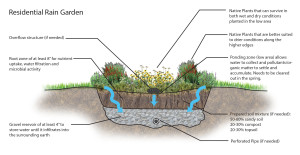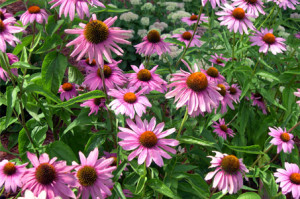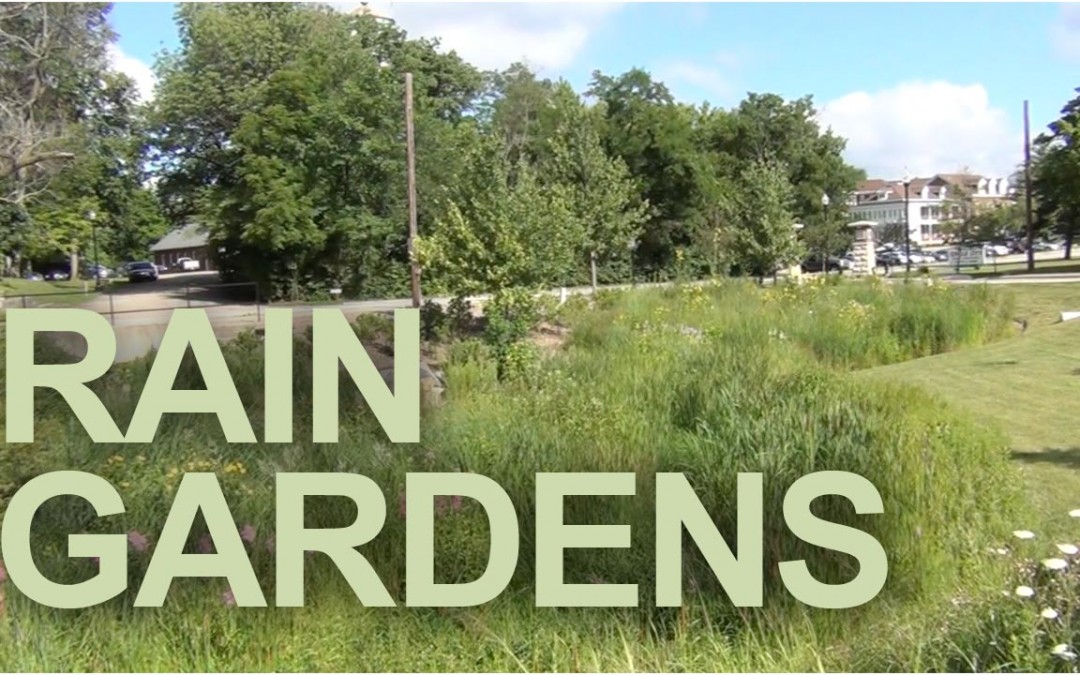This is the second in our series on the use of native plants and sustainability. The blog is about how rain gardens help clean our water and the environment.
This is the second article in our series As the ‘Green Movement’ continues to gain steam and the growing awareness that toxins are entering our rivers, lakes, and streams continues to build, many clients are asking for landscape designs that offer form and  function that benefit the natural ecosystem.
function that benefit the natural ecosystem.
Many people are requesting rain gardens. The purpose of a rain garden is to capture storm water and allow the soil and garden plants to soak it up. This process helps cleanse the water of pollutants and reduces the amount of runoff that enters storm sewers that ultimately end up in rivers, lakes and streams. Rain gardens, on a small scale, mimic the natural hydrological cycle of wetlands, prairies, and woodlands that have been long removed from most urban settings.
Rain gardens are shallow landscaped depressions typically sited near points of runoff, such as gutter downspouts or patio and driveway surfaces. They can also be constructed in natural drainage swales, ditches, or low lying areas. Downspouts can often be routed with drainage pipe to the area of the rain garden or in some cases installed in very close proximity.
Rain Gardens are best suited for a sunny location, as a majority of the most vigorous blooming plants thrive in sunny locations. These plants offer the widest diversity in species and flower color and often invite birds, butterflies, and pollinating bees. Rain gardens can be designed into shadier spaces, however, the number of viable plant species is much more limited. Shady areas lack sunlight and can take much longer to dry out.
 Native Indiana plants are best suited for use in rain gardens. Natives are already adapted to the extremes in temperature and precipitation we experience. Once established these plants require much less water than non native species and grow very deep root systems, improving infiltration, water retention, and drainage over time, thus improving water quality.
Native Indiana plants are best suited for use in rain gardens. Natives are already adapted to the extremes in temperature and precipitation we experience. Once established these plants require much less water than non native species and grow very deep root systems, improving infiltration, water retention, and drainage over time, thus improving water quality.
Rain garden plant species are not limited to just perennials and grasses, many native trees and shrubs can and should be introduced to provide a more defined garden space. Boulders, cobbles, and stone can also be incorporated, adding a more natural element. They help slow the water velocity as it moves through the garden.
The following woody plant species are well suited for inclusion in a rain garden; Cephalanthus occidentalis, Lindera benzoin,  Amelanchier laevis, Taxodium distichum, and Quercus species.
Amelanchier laevis, Taxodium distichum, and Quercus species.
Some perennial plant species suited for rain gardens include; Sporobolus heterolepsis, Echinacea purpurea, Rudbeckia fulgida, Asclepias incarnata, Solidago rugosa, Panicum virgatum, Liatris spicata, and Lobelia cardinalis.
Rain gardens can be implemented into most any landscape and do not require a large space to be effective. They are a very personal way to help clean our water and improve the environment.
If you would like to see a video vlog of this blog on YouTube, Click Here!

